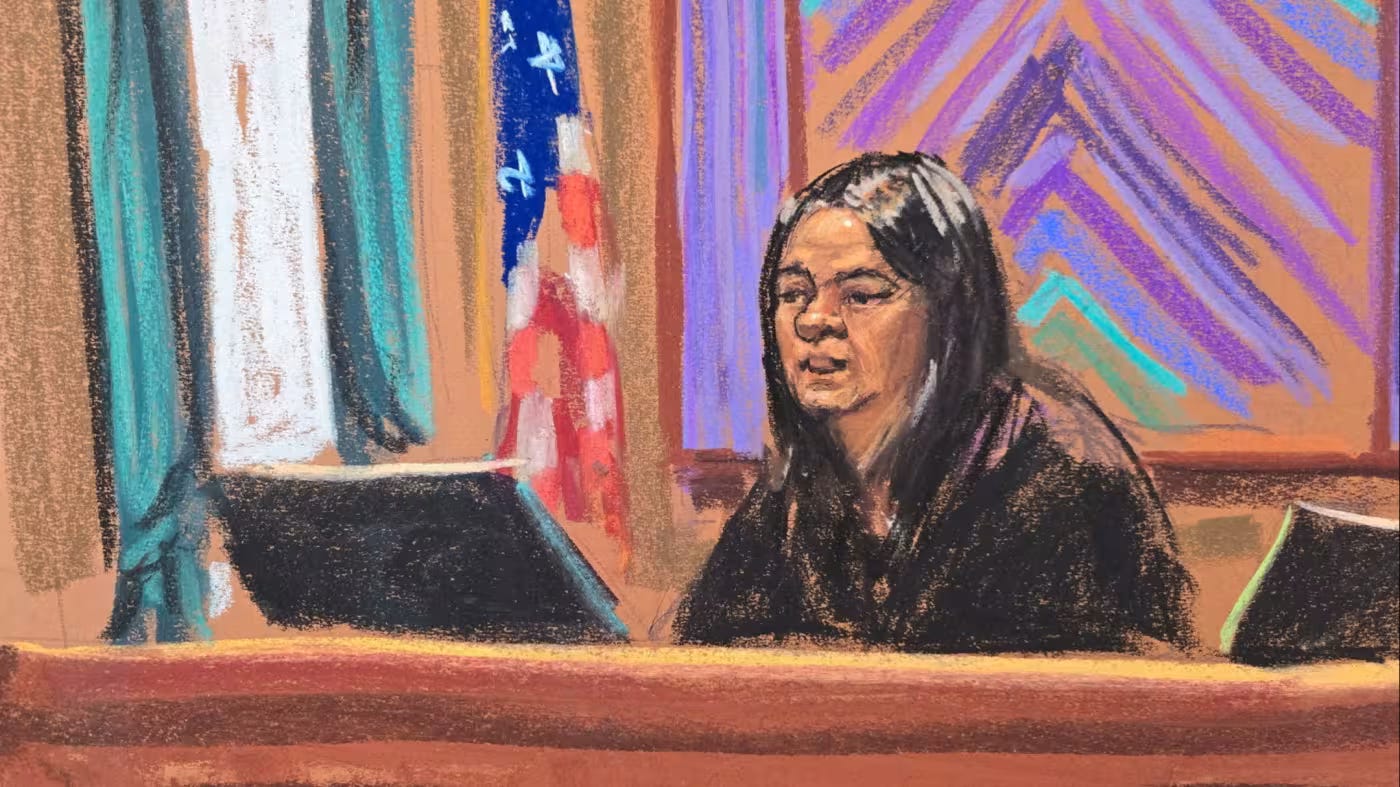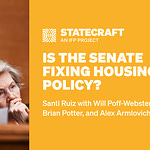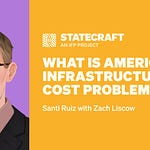We recorded today’s Statecraft after I saw this tweet from friend-of-the-pod Nick Bagley, and realized that we had to have him on immediately.
What’s going on here? As President Trump kicks off his second term with a flurry of executive orders, his administration is being hit with a wave of injunctions: that is, district judges around the country are ordering the federal government to pause all kinds of actions. Democrats are praising the judges, Republicans are criticizing them. But where do judicial injunctions come from? Why do they exist? Why is this moment “downright hallucinatory?” It turns out that this story isn’t straightforwardly about checks and balances. And at least one Democratic legal expert thinks judges are overreaching.
Bagley is an expert in administrative law who served as special counsel and chief legal counsel to Democratic Michigan Governor Gretchen Whitmer. We've had him on twice for conversations on how bureaucracy is breaking government and whether the courts broke environmental review with a recent decision.
Nick, you’re here to explain a concept that can sound scary to a lay audience: judicial review. Judicial review sounds like legalese, but it’s actually not especially complicated. At a basic civics level, most Americans have a pretty good handle on this.
Before we get into the big political controversies of the day, just refresh readers: what's judicial review?
Judicial review is the power of the courts to review government action. This is not actually the traditional office of the courts; the traditional role of the courts was to resolve private disputes. So if I punched you, you could sue me for battery and I'd potentially owe you money, and a jury would hear our dispute.
Over time, judges started playing a more central role in superintending what it is that the government does. It started out with constitutional review: the idea that the courts could review an act of Congress and decide whether it was consistent with the Constitution. That constitutional review still happens today, but the more important judicial review for the day-to-day functioning of the government comes through what you might think of as administrative review: a review of what an administrative agency or regulatory agency does.
Will you say a little bit more about that order of events? At first, judicial review in the American context mostly meant reviewing congressional decisions to determine whether they're constitutional. And only later did we add review of the executive branch?
The story is complicated. In the 19th century, judicial review looked very different than it does today. From the very beginning of the Republic, the Supreme Court asserted the power to decline to apply laws that it believed were inconsistent with the Constitution: the idea being that the Constitution is higher law, and it would trump any congressional enactment that flew in the face of that higher law.
In practice, federal courts were very ginger about reviewing acts of Congress and striking them down as unconstitutional, but it would do so from time to time. On the administrative side, the courts were even more hesitant to interfere with the day-to-day operations of the federal government. The executive branch doesn't sit to review the work of the Supreme Court. There was an idea that the courts likewise couldn't sit to superintend the decisions of the executive branch.
That meant that each of the branches were kept in tighter, separate spheres. There were still opportunities for the courts to say when a government agent might have gone too far in certain narrow circumstances, but that judicial review tended to be fairly narrow and circumscribed relative to what we have today. It really wasn't until the 20th century, the rise of the administrative state, especially the adoption of the Administrative Procedure Act in 1946, that we get something that looks like the review we are used to today.
We’re recording this on Valentine’s Day. In the past three or four weeks of the Trump presidency, there has been a flurry of executive orders: on buyouts of federal workers, shuttering or near-shuttering of executive agencies like USAID, immigration enforcement, on indirect costs at NIH, and so on.
A big pile of these executive orders have, to various extents, been immediately subject to injunctions; that is, to pauses from district court judges through this power of judicial review. Will you explain the mechanics? What's going on here? The president issues an executive order, and then what?
It's a little complicated. I should say: executive orders get a lot of attention in the press, but they're really not anything more than glorified press releases. They just instruct the president's minions to do what the president would like to do. And the president himself has actually fairly few powers that he exercises directly. Most of the powers of the federal government are vested in the secretaries of departments. What these executive orders say is, "Hey, you people that I've appointed to these positions, I'd like you to carry out my policy," and that matters, of course. But the executive orders themselves rarely have legal effect.
You get this executive order in place, and then the agencies move to implement that executive order. The Administrative Procedure Act of 1946 creates a presumption that “final agency action” is reviewable in court. When an agency moves to carry out the president's instructions and does one of those final agency actions, in principle, someone harmed by that agency action can sue over it. They can say, “We think that you have either violated the law or that you've behaved arbitrarily and capriciously.” In other words, you've behaved consistent with the law, but you haven't explained yourself enough, you haven't crossed your T's or dotted your I's, you've skipped some procedural steps.
What we're seeing now is a rash of lawsuits that are attempting to target the agency actions to carry out those executive branch executive orders.
Just to clarify terms here: these nationwide injunctions on things like offering a buyout to federal workers, that's not an injunction on the executive order itself. You can't stop the executive order. What you can do is try to stop the actual carrying out of an executive order by particular agencies.
That's exactly right. And I should add, nationwide injunctions themselves are actually pretty new on the scene over the past two decades as our politics has become more polarized, as more and more high-profile cases are brought into the judiciary. The courts have become much more comfortable enjoining the executive branch on a nationwide basis. But that's a pretty substantial shift.
It used to be the case that administrative review under the Administrative Procedure Act was much narrower. It would give much more deference to administrative agencies for a variety of different reasons. And, when an agency lost, the effects of that decision were limited to the parties that brought the lawsuit itself instead of extending nationwide.
Now we're seeing a judiciary that has become very comfortable with the muscular exercise of oversight authority for the executive branch. While it may seem that President Trump is running afoul of the courts an awful lot in these first few weeks, really we've seen this dynamic emerge across the last four or five presidential administrations: virtually every decision of any moment is immediately challenged in court, often by attorneys general in states that are controlled by the opposite political party.
Will you go into more depth on those changes over the last two decades? Did something change mechanically or legally that contributed to the rise of injunctions?
The rise of injunctions is a complicated story, but the rise of expanded judicial power is a little simpler, I think. It really has two sources. The first is that, starting in the early 1970s, there was a bipartisan consensus that the courts needed to “ride herd” on federal agencies to a much greater extent than they had before. In those giddy post-war years, there had been so much construction, so much heedless polluting of the environment, so much relentless action, that there were a lot of people saying, “We need to protect values that we think the agencies aren't paying enough attention to. So we need to make sure to protect the environment better, we need to take better care of civil rights,” and so on. A skepticism about governance took hold in the 1970s for a lot of good reasons, and that extended itself into judicial review, so you get courts acting in a much more assertive manner.
That’s a bipartisan consensus led by the left, but embraced as well by the right. It’s still the generally prevailing view: that we depend on courts to stand up to an executive branch that might run amok. A lot of Democrats and Republicans share that view.
What changed more recently is the rise of the conservative legal movement and its success in getting judges appointed to the bench. Starting in the 2000s, the Federalist Society made one of its key priorities trimming the sails of the administrative state: “We think unelected bureaucrats are driving industry into the ground. They are imposing lots of senseless rules without adequate justification. We need to get a handle on this distortion of our constitutional design. We need to put power back in the hands of elected officials. How are we going to do that? Well, we're going to get the courts to exercise even greater control over the administrative state than they have before.” [Full disclosure: this interviewer once worked on book promotion for Peter Wallison’s Judicial Fortitude: The Last Chance to Rein in the Administrative State.]
As a result, we’ve seen an increased assertion of authority in the federal courts over the executive branch. It was really consolidated with the demise of Chevron deference at the US Supreme Court last year, but it's been apparent in a lot of different doctrinal domains. Basically, the courts are saying, “We've been recumbent too long, we need to get back into the game.”
I know you said it’s complicated to explain why injunctions became more common in the last decades. But I want you to help me understand.
A lot of different things came together, but probably the most important factor is congressional dysfunction. In the early 2000s you have a much more polarized Congress, much deeper partisan divides, and a filibuster that makes it almost impossible to adopt any substantive legislation. You get a Congress that can't respond meaningfully to public demands and desires.
What that ends up doing is putting immense pressure on the president to go it alone, to try to use the existing powers that are on the books to achieve his objectives. Presidents are pushing at the boundaries to a greater extent than we'd seen in previous years. That's part of it.
At the same time, judges themselves became, I think, more polarized. We saw a higher percentage of them who became partisans in robes. When they saw presidential excesses pressing up against the boundaries of legal authority, they were offended. They were frustrated. They said, “This cannot stand,” and they pushed their authorities to the limit and said, “We're going to enjoin you not just as to these parties, but nationwide. You shouldn't have done that.” It's a self-righteous indignation that flows into the law.
That became so commonly accepted that it became almost part of the furniture. Judges started to think that's just the way administrative review works. There are some technical reasons why some judges started to think that way, but the end result was a practice of entering nationwide injunctions with some regularity against administrative actions that the judge happened to think were unreasonable or unlawful.
It's put us into a very bad place. Over the past few years, we've seen members of both parties start to recognize that nationwide injunctions can make individual district court judges into kings. They can make it really hard for the Supreme Court to hear orderly arguments about whether or not a particular administrative action is permissible, because once you get one nationwide injunction, there's a race on to the US Supreme Court to get it lifted or reimposed.
So I think there's some sense of, “maybe we've gone too far.” There's less of a sense of how to get out of the problem, and it's a collective action problem. Neither side wants to let their weapons go while the other side's in power.
Right. I'm going to push you even further here. What are some of the technical reasons judges began to impose national injunctions?
Yeah, okay, buckle up. The technical reason is actually at its base geographical. Almost all federal agencies are in Washington, D.C., which means that because of the venue rules that apply in the federal courts, almost any challenge to agency action can be brought in D.C. That, combined with specialized venue rules that channeled a lot of administrative actions to the D.C. Circuit, meant that D.C. became a center for administrative law challenges. The D.C. Circuit is the federal court that takes the lead on administrative law. When it reviews an agency action and says “We think this is impermissible,” in a way it doesn't matter if that decision applies just to the party in front of it or to the whole country: if it applies just to the party in front of it, somebody else who's unhappy about that decision can just file in D.C. In D.C., by matter of precedent, that decision's already been resolved, and the challenger automatically wins. So if the government's going to lose as to one party in the D.C. Circuit, it's gonna lose as to the entire country.
So the D.C. Circuit judges started to say, “Well, when we set aside an agency action, we're really, as a practical matter, setting it aside nationwide.” You can see how D.C.'s strange jurisdictional reach affects their thinking, and led to a comfort and a familiarity with nationwide scope of relief that translated very easily to district judges in other districts across the country as a tolerance and an embrace of nationwide injunctions. That's part of the story as well.
The two times someone has used the phrase "to ride herd on a federal agency" on this podcast are the only two times that I've actually heard the expression in the wild. And the two people who have used it are you and Trump's head of the Office of Management and Budget, Russ Vought.
It's hopefully one of the few things that we have in common.
Well, it's funny, because this whole conversation, to my eye, is about another thing that you guys have in common. You share a view that, generally speaking, we have too much judicial involvement or oversight, too many injunctions of executive branch actions.
[Here’s our conversation with OMB Director Russ Vought.]
I wanted to talk to you about this in particular because the Trump administration has cried bloody murder about a bunch of these injunctions. You have Stephen Miller saying district judges shouldn't be able to set policy for the nation. You have Vice President Vance coming out and saying similar things. Elon, of course, tweeting quite a bit about this, in even more strident terms than the elected officials.
I won't put words in your mouth, but I think you largely share this view of the judicial branch as overreaching in its oversight of the executive. Will you compare and contrast your view with the administration’s?
When I got out of law school, I clerked for a couple of years and then went to work for the Justice Department, where my job was defending the US government. It became pretty clear to me quickly that the potted vision of judicial review that I'd learned in law school didn't resemble reality. I wasn't defending the US government from lawsuits brought by scrappy upstarts at all. I was mostly defending the US government from lawsuits brought by well-heeled businesses and gadfly groups that wanted to achieve some private advantage. It got me thinking that this judicial review thing was less noble than it was cracked up to be.
Over the past 15 years in the academy, I've become more persuaded that judicial review can become a very serious impediment to the smooth functioning of government operations.
One of the ways you can wrap your head around this intuitively is to imagine you were running a small business. Every time you made an important decision, a three-judge panel of lawyers — who knew nothing about how to run a gym or a catering business — would tell you that you were making good decisions or bad decisions. We all understand that it would be a pretty intolerable way to try to actually run a business. In fact, we have rules that are quite deferential to business judgment for exactly that reason. But in the space of administrative law, we think that approach is completely fine.
Now, there are some good reasons for that: administrative agencies have a regulatory power that private businesses don't. But the fact is that judicial review really can impede smooth administration to a degree that lawyers often don't pay enough attention to.
One place you can see this is with environmental review. You know, “the National Environmental Policy Act,” it sounds really good. Agencies should think about the environment before they act. Nobody can really object to that. But what happens when you subject environmental review to judicial review is that agencies get so panicky about the possibility of losing in court in front of a generalist judge who knows nothing about the domain in which they regulate that they write these thousand-page environmental statements where they chased on every conceivable available alternative, where they hired consultants through the nose — and that's in cases where the projects get off the ground. Agencies are also apt to say, “Look, I'm just not even going to touch this because I can't imagine the compliance burdens.” That's the problem that judicial review can lead to.
So Russ Vought and I share a concern about the day-to-day interference of the courts in government action. There is something really untoward about letting a bunch of black-robed generalists come in and fly-speck agencies over what they're up to.
There's a stronger case for the courts to intervene when agencies have exceeded their legal mandate. I’ll roll the tape back to something I said earlier: there are two styles of administrative review. One is legal review, where you say “You've gone beyond what Congress allowed you to do.” There's a stronger case for that, and where we're seeing the Trump administration bridle at some of the legal constraints that Congress has placed on it, it seems pretty appropriate for the courts to step in.
There's a different judicial review that worries me a lot more, which is where courts will say, “Has the agency acted arbitrarily or capriciously?” That's language from the Administrative Procedure Act. The way courts adjudicate that is to decide if the agency has behaved “reasonably.” Courts aren't in a terribly good position to judge the reasonableness of an agency action, and it creates a lot of pathologies when agencies plow so many resources into creating defensible administrative records, instead of just making the best decision and moving on to the next problem at hand.
Will you bucket the recent injunctions of the Trump administration into those two categories? I know at least some — like the injunction on the NIH's decision to reset the amount that universities can take on top of research grants — are a question of legal review. Congress said “We'll manage costs a certain way,” and the NIH is trying another way.
Yeah, that challenge to the limitation on NIH indirect costs is primarily a legal challenge. It's a little tricky to disaggregate the two, mostly because you tend to bring both. When you challenge the NIH cutting of indirect costs, you say both “It's unlawful” and “It is arbitrary and capricious.” For a lot of these Trump actions, both arguments are going to hold some appeal.
Some of the injunctions, it's hard to know exactly what the basis is, because they're temporary and the judges haven't yet explained them. Take the injunctions over funding freezes, for example: there's a question about whether they are best understood as challenges to the legal requirement that agencies spend money, or as an “arbitrary and capricious” challenge to a blanket order that wasn't taken with the deliberation or care that we'd normally expect of a decision of that magnitude.
I think we're waiting to see how these cash out. To the extent that they rest on a firm legal foundation, I'm less concerned. To the extent that they are liberal judges who are worried about Trump administration policy, and are leveraging those anxieties about policy to stop the administration from doing stuff, I have more concerns — not because I disagree on the merits, I'm worried about lots of the stuff that the Trump administration is doing — but because that practice is, on balance and over time, destructive to good governance.
Conservatives have generally criticized the administrative state on the grounds that unelected bureaucrats are setting policy. Your view is that it's not really appropriate for unelected judges to be setting policy, but we should have bureaucrats and administrators doing the work of administration. That is, your critique is slightly different from the Federalist Society view.
I think this whole unelected thing is a bit of a canard. It turns out we can only elect a few people in any given year. There are gonna be folks carrying out government policy who aren't elected. The question is, who ought they to be? Our answer for a long time has been, “bureaucrats, but only if a court says it's okay.” I think that's a terrible way to try to run a government. I think we need to do much less judicial review, and we need to trust the political process more.
I say that in full recognition that the political process sometimes misfires — I think we're in such a moment right now — but I haven't heard yet a suggestion about how to improve on democracy as a way of running the United States. Mechanically, it's a terrible approach to have judges — many of whom are quite partisan themselves — second-guessing and fly-specking government decisions because they happen to disagree with them on the merits.
I want to commend you for consistency, because you made a similar case to me a few months ago, in the late days of the Biden administration. We were on a panel, and a conservative friend of mine in the audience argued that judicial review is necessary to keep political actors from overstepping their mandate. Your response then, as now, was, “The way we do that is at the ballot box.” I'm paraphrasing you.
I think what I said is, you can win elections, too. And then of course, Trump did.
You made that argument from the left to the right a few months ago, and you're making that same argument now to folks on your side. It's a difficult moment to make a case against judicial review of the executive to Democrats, because they’re in for four years of this. How is that argument being received?
I start by reminding people that Trump is temporary, and administrative law is permanent.
That's a nice Valentine's formulation.
Yeah, I put it on a little heart.
It's tempting to think that you can structure the law to achieve the objectives that you like, and to thwart the objectives of the other guys you dislike. Law doesn't really work like that. It's never really worked like that, and we ought to stop trying to jerry-rig outcomes by coming up with just the right set of procedural constraints to allow us to achieve our objectives and to stop them from achieving theirs. I think it's a bad way to go.
How is it being received on the left? So I definitely think this is not the time when I'm going to be invited to the best cocktail parties.
But there is more appetite on the left than I've sensed in the past to revisit some of the accepted byways of how we've gone about doing things. There's a thought that one reason Biden lost is because people were disenchanted with what the government was able to accomplish. Now, whether you buy that diagnosis or not, the American public has a lot of reasons to be unhappy with the quality of governance in the United States. So folks are looking around and asking, how did we get here? And one of the answers — and it's not the whole answer, but it's an important piece of the puzzle — is that we put courts much too much at the center of how we go about our business. I think people are open to revisiting some of the accepted byways.
There’s this interesting feature of the political moment, this role reversal. You have Republican congressmen saying we need to find ways to limit the judicial review of agency action, when historically conservatives have been the ones championing judicial review.
On the other side, you have Democratic lawmakers arguing that upholding judicial review is the last bastion of a free democracy. It’s the last chance of stopping what are, in their view, the worst excesses of the Trump administration from becoming actual policy. What’s going on ideologically here?
Adrian Vermeule is a Harvard Law professor who does administrative law, and he calls this the Merchant-Ivory Ballroom Scene. The idea that it's like a Jane Austen movie, and there's a dance where the parties are on each side of the wall, and then they switch sides. When they switch sides, everybody, of course, changes their position.
That's often what you see with administrative law: people embrace the rules that they think will advance their team's agenda. I don't expect to see the conservative legal movement shift its approach to judicial review. I think they mostly distrust the bureaucracy to such an extent and degree that they prefer that judges they've had a lot of success installing in the federal courts remain on the watchtowers. But it is interesting how frustrations emerge when your guy is finally in power, and the apparatus you've helped to create turns out to be a problem for him, just like it was for the last guy.
If you’ve enjoyed this conversation, check out our two other episodes with Nick:
Did the Courts Just Nuke Environmental Review?
Today, we’re diving into everyone’s favorite Statecraft topic: administrative law. Before you tune out, give us a chance: the two court cases we’re discussing could have huge ramifications for how we build things in America.
How Bureaucracy Is Breaking Government
At the Abundance Conference a few weeks ago, today’s guests joined me on a panel to discuss “How Bureaucracy is Breaking Government.” They were so insightful that I invited them back to re-record the conversation for Statecraft.
Let me close with a forecasting question. Will we see challenges to the current world of district injunctions as a legal question over the next four years? Will they get taken up by SCOTUS and resolved?
In general, it is very difficult to change the rules that govern administrative law. There tend to be few organized interests that want to go to Congress to get the law changed. It's easy to find a constituency that wants to get a particular tax break, or to get some regulatory relief. But so many people are affected by the Administrative Procedure Act in such a broad and diffuse way that there is very little pressure to rethink it.
The exception has been on the right, where there have been some pretty aggressive proposals to rein in the administrative state, to actually make it harder for agencies to do stuff and increase the intensity of judicial review. You’ll hear names like the REINS Act.
The challenge for the REINS Act is that it's a Republican initiative, right? It's a thing that you want to do because you believe in limiting the power of the bureaucratic state. But the only time you can get it signed into law is if you have a Republican president. But the Republican president is in charge of the administrative state, and the last thing a Republican president wants is constraints on his own power.So it's very difficult to get a law designed to narrow administrative discretion adopted into law under either a Democratic administration or a Republican administration.
The place where you might see some action, which I think I'm cautiously optimistic about, is the basket of things that travel under the phrase permitting reform. There's obviously a deregulatory pro-investment story to be told that appeals across the political spectrum. Maybe we can see some movement on the permitting reform side, but I'm not optimistic that we're going to see broader changes to administrative law.
How quickly should we expect these injunctions to get taken up and resolved?
Every legal case is its own little snowflake, so it's difficult to predict. It depends on whether there's been injunctive relief entered, which can accelerate the pace of appeal quite dramatically, it depends on whether the government wins or loses, and whether they are aggressively moving to get the case through the system.
Because of the number of injunctions, and because of the extent to which the Trump administration seems committed to following through on some of them, I suspect we're going to get some action on at least a few of them pretty quickly. The first involvement to the US Supreme Court is likely to be on what's become known as its shadow docket, which is to say, not because a full dress case has worked its way through the courts — that normally takes between two and three years — but because an injunction has been entered, and people are sprinting to the US Supreme Court to get that injunction lifted, or to get an injunction put back into place. Because the Supreme Court has been much more active on its shadow docket over the past decade, I think we are likely to see some early action there as well. But time will tell.

















